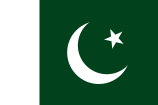Multan (Urdu: ملتان) is a city in the Punjab Province of Pakistan and capital of Multan District. It is located in the southern part of the province. Multan District has a population of over 3.8 million—according to 1998 census—and the city itself is the sixth largest within the boundaries of Pakistan. It is situated on the east bank of the Chenab River, more or less in the geographic centre of the country and about 966 km (600 mi) from Karachi.
Multan is known as the City of Sufis due to the large number of shrines and Sufi saints from the city. The city is full of bazaars, mosques, shrines and ornate tombs. It is located in a bend created by five rivers of the Punjab province. The Sutlej River separates it from Bahawalpur and the Chenab River from Muzaffar Garh. The city has grown to become an influential political and economical center for the country, with a dry port and excellent transport links. Multan is famous for its crops: wheat, cotton and sugar cane as well as mangoes, citrus, guavas and pomegranates.
Multan, is one of the oldest cities in South Asia.
Multan was ruled by various Hindu empires for over 1000 years. Multan was part of the Mauryan Empire and the Gupta that ruled much of northern India. These nomads were successful in taking the city, but did not stay, and the long-standing Hindu rule over the city was reestablished. The noted Chinese traveller Huen Tsang visited Multan in 641 AD.
During the Hindu period, Multan was known as the city of gold for its large and wealthy temples.
In the 7th century, Multan had its first experience with Muslim armies. However, only a few decades later, Muhammad bin Qasim would come on behalf of the Arabs, and take Multan along with Sind.
Multan has traditionally been a melting pot of several distinct ethnic groups due to its location at the intersection of all four of Pakistan's main provinces and due to its historical significance as a centre of learning and culture. As a result, Multan today consists of Saraiki, Haryanvi, Punjabi, Baloch, Pashtun, Sindhi, and Urdu-speaking Muhajirs who arrived at the time of independence in 1947.
According to a Persian saying, Multan was famous for four things: heat, dust, beggars and burial grounds. The latter were the magnificent tombs of various Sufis, or Islamic mystics. Legend has it that one Sufi deployed his miraculous powers to lure the sun closer to earth, thus creating Multan's crippling heat. In the 4th century B.C., Alexander the Great swung through town on his world tour, almost dying there when an Indian spear punctured his lung. Seven hundred years later, a Chinese traveler found a mammoth Hindu temple in Multan. Not a brick of it survives today, although a tiny community of Hindus does.
They live in Railway Colony, an area near the station with crumbling brick houses and narrow, cobbled lanes. It is mainly inhabited by Christian descendants of rail workers employed during British rule. About 35 Hindus cluster among them, where they feel more secure (most Hindus in Punjab province fled over the border after partition). I watched as a small temple, shaded by a hallowed pipal tree, slowly filled up with worshipers. Inside was a tinsel-draped shrine loaded with votive fruit and smoldering incense. A sign above it read, "Om sweet om."
Multan's Hindus have many grievances—grievances echoed by Pakistani Christians I spoke to. Muslims are always favored when it comes to job offers or college places, they say. "We are poor—much poorer than the Muslims," says Parwan Lal, a 20-year-old arts student. Yet Parwan and his friends claim they would not hesitate to defend Pakistan against any aggression from their Hindu brethren in India. "I'm a Pakistani first, and a Hindu second," says Chaman Lal, 20, another student. "We will defend our motherland, just as Muslims in India would fight to defend their country against Pakistan."
Was this simply the necessary patriotism of a minority, part of an embattled community's highly-evolved instinct for survival? I'm sure it was heartfelt: even casual visitors are impressed by Pakistani patriotism. Yet Pakistanis seem to love their country without being particularly proud of it, a schizophrenic attitude they share with my compatriots, the English.
















awasummmmm bhiraa medi family vi jaoti tu migrate thi kai ayyi si india i like u blog keep it up we r wid u
ReplyDelete